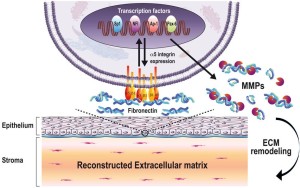Lake J, Zaniolo K, Gaudreault M, Carrier P, Deschambault A, Bazin R, Germain L, Salesse C, Guérin SL. Expression of the α5 integrin gene in corneal epithelial cells cultured on tissue-engineered human extracellular matrices. Biomaterials. 2013 Sep; 34(27):6367-76.
Impact scientifique: La reconstruction cornéenne par génie tissulaire est une avenue prometteuse pour répondre à la demande croissante de greffes. Une bonne régénération tissulaire nécessite toutefois une très bonne compréhension des signaux qui guident ce procédé. Cette étude démontre l’influence des différentes composantes d’une matrice extracellulaire reconstruite par génie tissulaire sur l’expression du gène de la sous-unité a5 de l’intégrine a5b1 dans des cellules épithéliales de la cornée humaine. Cette régulation de l’expression de a5 par la matrice est d’une importance primordiale dans la guérison des plaies cornéennes, puisqu’elle permet aux cellules de l’épithélium d’adhérer et de migrer correctement durant ce processus.
Contribution du Réseau: Le RRSV (Banque de tissus oculaires) a fourni les cellules épithéliales et les fibroblastes de cornées humaines indispensables à ce projet inter-axes (LG, SLG: cornée et segment antérieur; CS: rétine et segment postérieur; et RB: clinicien).
* * *
Résumé Original
Purpose: The integrin α5b1 plays a major role in corneal wound healing by promoting epithelial cell adhesion and migration over the fibronectin matrix secreted as a cellular response to corneal damage. Expression of a5 is induced when rabbit corneal epithelial cells (RCECs) are grown in the presence of fibronectin. Here, we examined whether a5 expression is similarly altered when human corneal epithelial cells (HCECs) are grown on a reconstructed stromal matrix used as an underlying biomaterial. Methods: CAT/a5-promoter recombinant plasmids were transfected into HCECs grown on BSA or on a biomaterial matrix produced by culturing human corneal fibroblasts with ascorbic acid (ECM/35d). The composition of the reconstructed matrix was determined by mass spectrometry and immunofluorescence analyses. Expression of transcription factors (Sp1, AP-1, Pax6 and NFI) that are important regulators of α5 gene expression was monitored by microarrays, qPCR and Western blot. The DNA binding properties of these TFs was determined by EMSAs. Results: Mass spectrometry and immunofluorescence analyses revealed that the biomaterial matrix (ECM/35d) contains several types of collagens, fibronectin, tenascin and proteoglycans. Results from transfection of CAT/a5-promoter plasmids, Western blot, EMSA and microarray analyses indicated that ECM/35d significantly increase expression of the α5 promoter in HCECs as a result of alteration in the expression and DNA binding of the transcription factors NFI, Sp1, AP-1 and Pax6. Furthermore, the ECM/35d increase expression of many MMP genes, most notably that of MMP-9 and MMP-10. Conclusions: The tissue-engineered ECM/35d causes important changes in the activity of the α5 gene promoter as well as genes, such as MMPs, that play important functions in the remodeling of the newly reconstructed stromal matrix. The biological significance of this biomaterial substitute may therefore contribute to better understand the functions played by the a5b1 integrin and MMPs during corneal wound healing.
Modèle d’action de la matrice extracellulaire sur l’expression du gène a5. Par l’intermédiaire des récepteurs membranaires de la famille des intégrines qui leur sont spécifiques, les diverses composantes de la matrice extracellulaire peuvent influer sur l’expression et la liaison à l’ADN des facteurs de transcription (Sp1, NFI, Pax-6 et AP-1) qui contrôlent l’expression du gène a5 ainsi que de plusieurs gènes qui codent pour diverses métalloprotéinases matricielles (MMP). L’expression ainsi modifiée de a5 modifie son abondance à la surface de la cellule et par conséquent, ses propriétés adhésives et migratrices. Par ailleurs, la production accrue de certaines MMPs permet le remodelage de la matrice requis pour favoriser ces deux processus (adhésion et migration).



